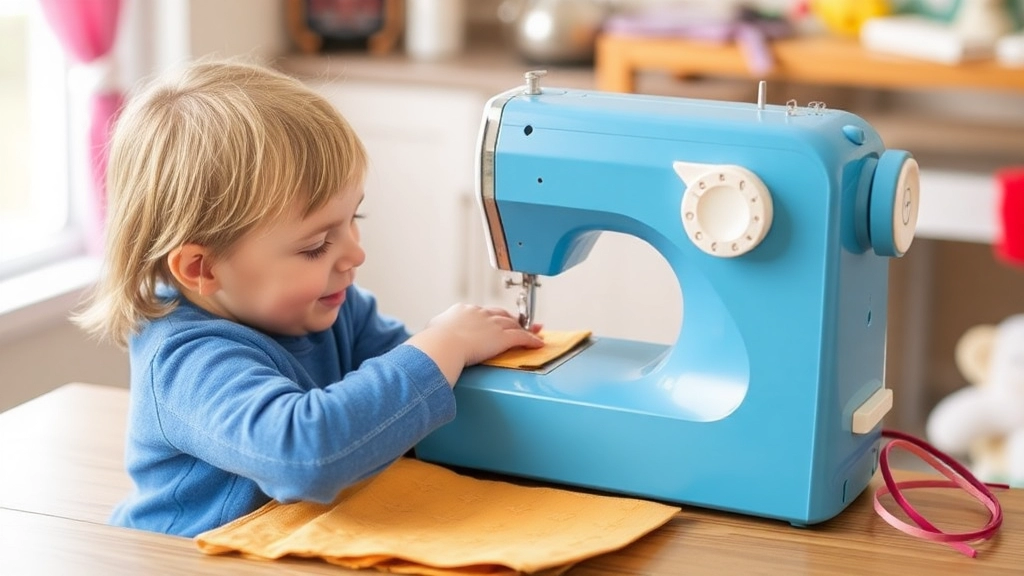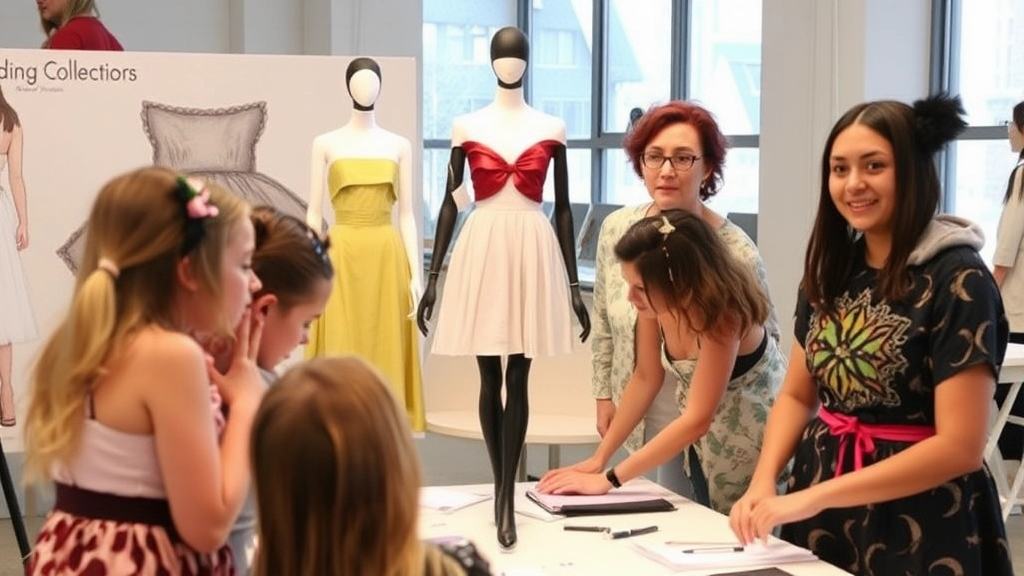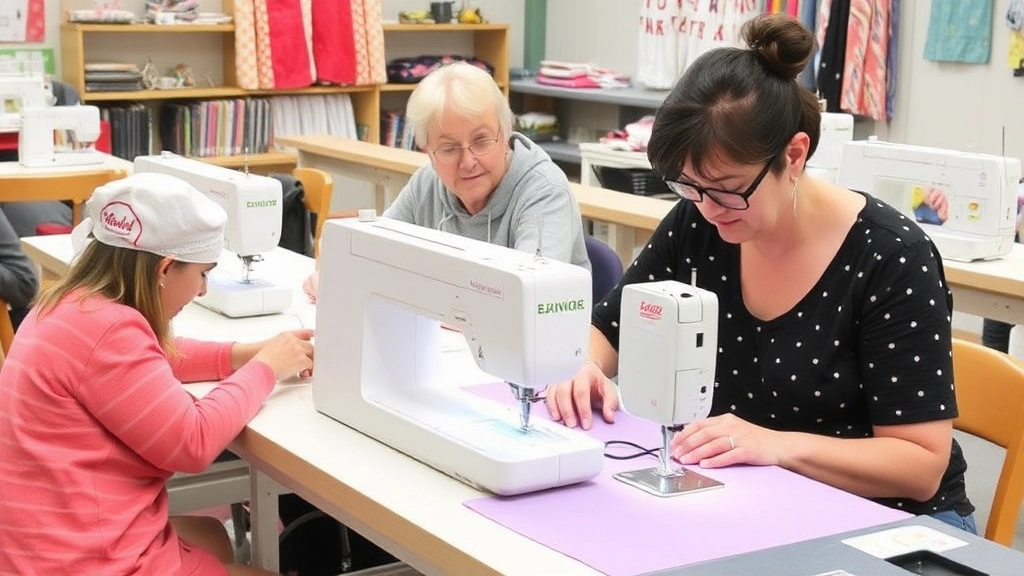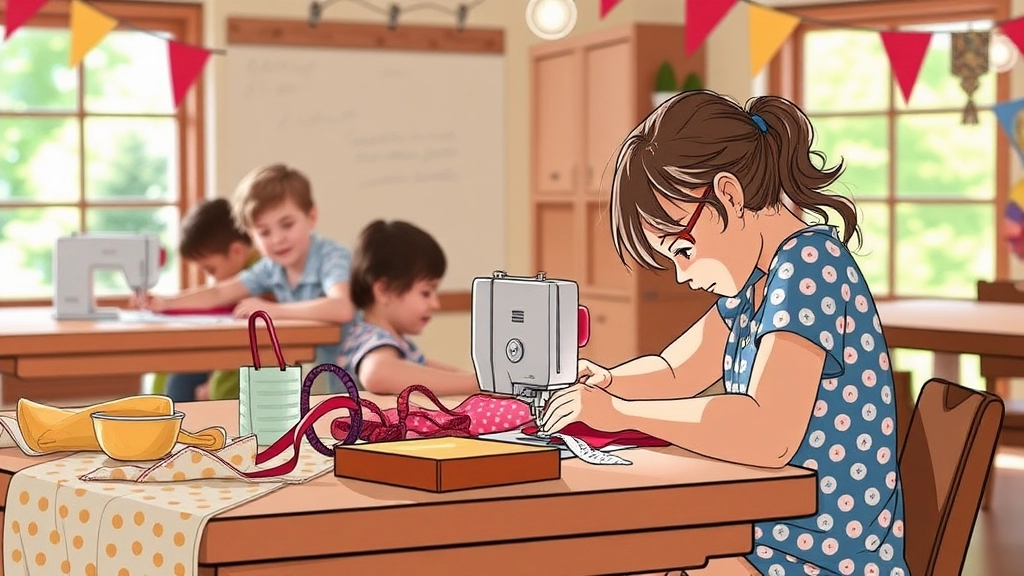Transform Your Skills and Creativity at Summer Camp
Ever wondered how a summer camp sewing experience could transform your skills and creativity? You’re in the right place. This article dives deep into the world of sewing camps, catering to different age groups and skill levels. From beginner-friendly projects for younger children to advanced techniques for seasoned enthusiasts, there’s something for everyone. Whether you’re interested in fashion design, crafting beyond clothing, or specialized workshops like quilting and embroidery, these camps offer hands-on learning in small group settings to ensure personalized attention and growth.
Choosing the Right Camp
Choosing the right camp can be daunting, but we’ve got you covered. We’ll guide you through assessing your skill level, understanding camp schedules, and knowing what materials and supplies you’ll need.
Benefits of Sewing Camps
Plus, we highlight the incredible benefits of sewing camps, from building confidence and creativity to fostering a sense of achievement and community. Ready to stitch your way to new skills and unforgettable experiences? Let’s get started!
Variety of Sewing Camps Available for Different Age Groups
Ever wondered if sewing camps are just for kids or if there’s something for everyone? You’re not alone. Let’s break it down.
Why Sewing Camps?
Sewing camps are a fantastic way to dive into the world of stitching, whether you’re a newbie or have been sewing for years. But here’s the kicker: there’s a camp for every age group. Yep, from the littlest hands to the seasoned pros, there’s a spot for everyone.
Camps for Younger Kids
Got a child who’s always curious about how clothes are made? There are beginner camps designed just for them. These camps focus on:
- Basic Sewing Skills: Threading a needle, simple stitches, and understanding the sewing machine.
- Fun Projects: Think small pillows, simple tote bags, or even a basic stuffed toy.
These camps are perfect for kids to get their feet wet without feeling overwhelmed. If you’re looking for other fun and safe options for younger kids, consider checking out Country Day Summer Camp.
Camps for Teens
Teens are a different story. They’re ready for a bit more challenge. Camps for this age group often include:
- Intermediate Techniques: Zippers, buttons, and more complex stitches.
- Fashion Projects: Simple skirts, tops, or even customising their own clothes.
These camps help teens express their creativity and start building a unique style. For teens interested in a variety of activities, Lee County NC Teen Summer Camps offers a range of options.
Adults and Advanced Camps
Now, if you’re an adult or have some serious sewing skills, don’t think you’re left out. There are advanced camps that cover:
- Complex Sewing Techniques: Draping, pattern making, and couture methods.
- Fashion Collections: From sketching designs to creating an entire collection.
These camps are intensive but incredibly rewarding, perfect for those looking to take their sewing to the next level.
Family Camps
Yes, you heard that right. There are even family sewing camps where parents and kids can learn together. It’s a great way to bond and create something special as a team.
Why It Matters
Choosing the right camp based on age and skill level is crucial. It ensures that the experience is enjoyable and that everyone learns at their own pace. Plus, it’s a fantastic way to build confidence and creativity, no matter your age.
Beginner Sewing Skills and Projects for Younger Children

Worried about how to get your child started with sewing?
I get it. It can seem daunting.
But trust me, it’s easier than you think.
Beginner sewing camps are designed just for this.
Why Start Young?
Kids are curious.
They love creating.
Sewing taps into that.
It’s not just about making clothes. It’s about developing skills.
What Do They Learn?
Basic Skills:
- Threading a needle
- Simple stitches like running stitch and backstitch
- Using a sewing machine (yes, even the basics!)
Projects:
- Easy-to-make pillows
- Simple tote bags
- Fun stuffed animals
These projects are fun and build confidence.
Why It Works
Small wins.
Every project they complete boosts their confidence.
It’s like a snowball effect.
Real Stories
I remember my niece.
She was 7.
Started with a simple pillow.
By the end of the camp, she was making her own tote bag.
She was proud. We were proud.
How Do They Teach?
Small groups.
Hands-on learning.
Instructors guide every step.
Kids feel supported.
What Parents Need to Know
Materials and Supplies:
- Everything is usually provided
- Some camps might ask you to bring a basic sewing kit
Schedules:
- Typically half-day sessions
- Might run for a week or two
Benefits
- Builds creativity
- Enhances motor skills
- Boosts problem-solving abilities
Advanced Sewing Techniques for Experienced Students
Are you ready to take your sewing skills to the next level? Maybe you’re wondering if you’re ready to tackle more complex projects or if you’ll just end up tangled in threads. Let’s break it down.
Why Advanced Sewing?
Advanced sewing techniques aren’t just for the pros. They’re for anyone ready to push their boundaries. If you’ve mastered the basics and are itching for a challenge, this is your moment. Think about it: wouldn’t it be awesome to create garments that look like they came straight off the runway?
What to Expect in Advanced Sewing Camps
These camps are designed for those who have a handle on the basics and are ready for more. Here’s what you might dive into:
- Tailoring and Fit Adjustments: Learn how to tailor clothes to fit like a glove.
- Complex Patterns: Tackle intricate designs that require precision.
- Fabric Mastery: Work with challenging materials like silk or leather.
- Creative Techniques: Discover embellishments, pleating, and more.
Real Stories, Real Skills
Imagine Sarah, who started sewing simple skirts and now designs her own dresses. She joined an advanced camp, and her confidence soared. She learned to add pockets, zippers, and even created a fully lined jacket.
Hands-On Learning in Small Groups
You’ll love the small group setting. Why? Because you get:
- Personalised Attention: Instructors can focus on your specific needs.
- Collaborative Environment: Share ideas and get feedback from peers.
- Real-Time Problem Solving: Tackle challenges as they arise.
Choosing the Right Camp
Feeling overwhelmed by choices? Here’s a quick guide:
- Skill Level Assessment: Look for camps that match your current abilities.
- Project Focus: Choose based on the projects you’re excited about.
- Instructor Expertise: Learn from those who’ve mastered the craft.
Camp Schedules and Supplies
Before you sign up, know what you’re getting into:
- Daily Schedule: Typically includes a mix of instruction and hands-on practice.
- Materials: Some camps provide everything; others might require you to bring your own.
Benefits of Advanced Sewing Camps
Why bother with advanced sewing? Because it builds:
- Confidence: Mastering new skills boosts your self-esteem.
- Creativity: Pushes you to think outside the box.
- Community: Connects you with like-minded enthusiasts. If you’re interested in exploring creativity further, consider joining summer art camps.
For those who want a comprehensive guide to selecting the right camp, check out our ultimate guide to summer camps.
Fashion Design Camps: From Sketching to Creating a Collection

Ever wondered how you can turn your fashion dreams into reality?
Fashion design camps are where it all starts.
Why Fashion Design Camps?
Let’s be real.
Diving into fashion can be overwhelming.
Where do you start?
Sketching?
Sewing?
Or maybe you’re just curious if you’ve got what it takes to create a collection.
These camps break it down.
What Happens in Fashion Design Camps?
You start with the basics.
Sketching:
- Learn to bring your ideas to life on paper.
- Understand proportions and styles.
- Experiment with different designs.
Creating a Collection:
- Choose fabrics and colours.
- Sew your designs into reality.
- Get feedback and refine your work.
Hands-On Experience:
- Work on real projects.
- Collaborate with others.
- See your ideas transform from sketches to actual garments.
Why Join a Camp?
- Build Confidence: Learn at your own pace.
- Get Creative: Explore your unique style.
- Make Connections: Meet like-minded people.
Choosing the Right Camp
Not sure which camp suits you?
Think about:
- Your Skill Level: Are you a beginner or looking to advance?
- Your Interests: Do you want to focus on fashion or try a mix of sewing and crafting?
Expectations:
- Schedules: Usually flexible and accommodating.
- Materials: Most camps provide everything you need, but check beforehand.
- Support: Small groups mean more personalised attention.
Benefits of Fashion Design Camps
- Confidence: Create something from scratch.
- Creativity: Push your boundaries.
- Skills: Learn techniques that stick with you.
Crafting and Sewing: Creative Projects Beyond Clothing
Ever wondered if sewing camps are just about making clothes? Good newsâthey’re not. If you’re like me, you probably have a million questions about what else you can create. Let’s dive into the world of crafting and sewing camps that go beyond the wardrobe.
What Can You Make Besides Clothes?
You might be thinking, “Sure, I can sew a button, but what else can I do?” Here’s a list of cool projects you can tackle:
- Home Decor: Think cushions, curtains, and table runners. Imagine sprucing up your living space with your own creations.
- Toys and Dolls: Perfect for younger kids and those young at heart. Soft toys and dolls are always a hit.
- Bags and Accessories: From tote bags to headbands, these projects are both fun and functional.
- Seasonal Crafts: Holiday decorations, anyone? Halloween costumes, Christmas stockings, you name it.
Why Crafting Projects Rock
Here’s why crafting and sewing projects beyond clothing are a game-changer:
- Versatility: You get to try out different fabrics and materials, which broadens your skill set.
- Creativity: Crafting projects allow for more artistic freedom. You can mix and match colours, patterns, and textures.
- Practicality: Many of these items are things you’ll actually use or gift. How cool is that?
Real Stories, Real Projects
Let me share a quick story. Last summer, I attended a sewing camp focused on home decor. One of the projects was a custom cushion cover. Not only did I learn how to sew zips like a pro, but I also ended up with a cushion that perfectly matched my living room. My friends couldn’t believe I made it myself!
How to Get Started
If you’re thinking, “This sounds awesome, but where do I start?” Here’s a simple guide:
- Choose Your Project: Pick something that excites you. Whether it’s a tote bag or a seasonal craft, make sure it’s something you’ll enjoy.
- Gather Materials: Camps usually provide materials, but it’s always good to know what you’ll need. Check the camp’s supply list.
- Follow Instructions: Pay attention to the steps and don’t be afraid to ask questions. Remember, everyone starts somewhere.
- Personalise It: Add your own flair. Whether it’s a unique stitch or a special fabric, make it yours.
Why This Matters
So, why should you care about crafting and sewing beyond clothing? Simple. It builds your confidence and creativity. You’ll learn new skills, make useful items, and maybe even discover a new passion.
If you’re looking for more inspiration, check out our guide on summer camp indoor activities for fun projects you can do at home. And for those interested in sewing camps specifically for kids, our Spark Summer Camp is a great option for ages 6-16.
Specialized Workshops: Quilting, Embroidery, and Using Sergers

Ever wondered how to take your sewing skills to the next level?
Specialized workshops are your golden ticket.
Quilting, embroidery, and using sergers—these aren’t just buzzwords. They’re game-changers.
Why Specialized Workshops?
You might be thinking, “Why should I bother with a specialized workshop?”
Here’s why:
- Master Unique Skills: These workshops focus on niche techniques. Perfect for levelling up.
- Hands-On Learning: You get to dive in and practice, not just watch.
- Expert Guidance: Learn from pros who know their stuff inside out.
Quilting: More Than Just Patching
Quilting isn’t just about stitching pieces together.
It’s an art form.
What you’ll learn:
- Basic Patterns: Start simple. Master the classics.
- Fabric Selection: Not all fabrics are created equal.
- Layering Techniques: Get that perfect quilt sandwich.
Embroidery: Adding Flair to Your Projects
Embroidery takes your sewing projects from “meh” to “wow.”
What you’ll learn:
- Stitch Types: French knots, satin stitches, you name it.
- Design Transfer: Get those intricate patterns onto your fabric.
- Colour Theory: Make your designs pop with the right colours.
Using Sergers: Speed and Precision
If you’ve ever been frustrated by frayed edges, a serger is your new best friend.
What you’ll learn:
- Threading a Serger: It’s tricky but worth it.
- Seam Finishing: Clean, professional edges every time.
- Speed Control: Sew faster without sacrificing quality.
Real Stories, Real Results
Remember Sarah? She joined a quilting workshop last summer. Before, she was all about basic sewing. Now, she’s creating heirloom quilts that her family can’t stop raving about.
Or take Jake. He was stuck on simple embroidery designs. One workshop later, he’s crafting intricate patterns that look like they belong in a gallery.
How to Choose the Right Workshop
Feeling overwhelmed by the options?
Here’s a quick checklist:
- Skill Level: Make sure it’s right for where you’re at.
- Instructor Cred: Check reviews and credentials.
- Materials Provided: Know what you need to bring.
Hands-On Learning in Small Group Settings
Ever wondered if your child is getting enough attention in those big, chaotic classes? Or maybe you’re worried they’ll fall behind because they’re too shy to ask questions? Trust me, I get it. That’s where sewing camps with hands-on learning in small group settings come in.
Why Small Groups Matter
When it comes to learning something as intricate as sewing, the size of the group can make a big difference. Here’s why:
- Personal Attention: In small groups, instructors can give each student the one-on-one time they need. This is crucial for mastering those tricky stitches and techniques.
- Better Interaction: Kids can ask questions freely without feeling intimidated. This boosts their confidence and helps them learn faster.
- Tailored Feedback: Instructors can provide immediate, personalised feedback, helping kids correct mistakes on the spot. No more waiting for the next class to fix that crooked seam.
What Does Hands-On Learning Look Like?
Hands-on learning isn’t just a buzzword; it’s the backbone of these sewing camps. Think of it like this:
- Real Projects: Kids aren’t just watching demonstrations; they’re creating actual projects. From simple pillowcases to more complex garments, they get to see their progress in real-time.
- Step-by-Step Guidance: Instructors walk them through each step of the process. It’s like having a sewing mentor by their side, making sure they don’t miss a beat.
- Interactive Activities: These camps often include fun, interactive activities that make learning enjoyable. It’s not just about sewing; it’s about fostering a love for creativity.
Examples from the Trenches
Take Sarah, for instance. She was always interested in fashion but felt overwhelmed in her large school art class. After joining a small sewing camp, she flourished. The instructor noticed she had a knack for design and encouraged her to sketch her own patterns. By the end of the camp, Sarah had not only created a dress but also gained the confidence to pursue her passion further.
How to Choose the Right Camp
Choosing the right sewing camp can feel like finding a needle in a haystack. But here’s a quick checklist to make it easier:
- Skill Level: Make sure the camp matches your child’s skill level, whether they’re beginners or more experienced.
- Camp Size: Look for camps that cap their group sizes. Ideally, no more than 10-12 kids per instructor.
- Curriculum: Check if the curriculum includes hands-on projects and step-by-step guidance.
- Instructor Credentials: Ensure the instructors have experience and a passion for teaching kids.
What to Expect in Camp
Most sewing camps have a structured schedule, which usually includes:
- Daily Lessons: Focused on different techniques and projects.
- Materials and Supplies: Often provided by the camp, but check if there’s a list of items you need to bring.
- Breaks and Activities: To keep things balanced and fun.
Benefits of Sewing Camps
Beyond just learning to sew, these camps do wonders for kids:
- Building Confidence: Completing projects on their own gives them a sense of accomplishment.
- Fostering Creativity: They get to explore their creative side in a supportive environment.
- Developing Patience and Focus: Sewing requires attention to detail, which helps improve their concentration.
If you’re looking for a camp that offers hands-on learning and small group settings, consider checking out the variety of themes and ideas available. Additionally, for those in the San Antonio area, here are some top picks and tips for local summer camps.
How to Choose the Right Camp Based on Skill Level

Alright, so you’re thinking about signing up for a sewing camp, but you’re not sure which one to pick.
Been there, done that.
Let’s break it down.
What’s Your Skill Level?
First things first, figure out where you stand.
Are you a newbie or have you been sewing for a while?
Knowing your skill level helps you avoid wasting time and money.
Beginner? Start Here.
If you’re just starting out:
- Look for camps that cover the basics.
- Focus on hand sewing, basic machine skills, and simple projects.
- Think pillowcases, tote bags, and basic clothing items.
These camps often have a slower pace and more hands-on guidance.
Intermediate? Step It Up.
Got the basics down?
- Find camps that offer intermediate techniques.
- Projects might include more complex clothing items, like dresses or trousers.
- Learn about different fabrics, patterns, and maybe even some basic alterations.
These camps usually assume you can handle a sewing machine and follow a pattern.
Advanced? Go Big.
If you’re experienced:
- Look for camps that dive into advanced techniques.
- Think tailoring, couture sewing, and intricate patterns.
- You might even get into fashion design, sketching, and creating your own collection.
These camps are fast-paced and expect you to keep up.
Special Interests? There’s a Camp for That.
Got a niche interest?
- Check out specialized workshops.
- Quilting, embroidery, and using sergers are common focuses.
- These camps offer deep dives into specific skills.
Perfect if you want to master a particular technique.
Small Group Settings Are Gold.
Why?
- More one-on-one time with instructors.
- Better chance to ask questions and get detailed answers.
- You’ll probably make friends who share your passion.
Materials and Supplies
Most camps will provide a list of materials you need.
Some might include supplies in the fee.
Ask these questions:
- Do I need to bring my own sewing machine?
- Are fabrics and patterns included?
- What’s the daily schedule like?
Knowing these details helps you prepare better.
Benefits of Sewing Camps
- Boost your confidence.
- Unleash your creativity.
- Learn new skills in a fun, supportive environment.
What to Expect: Camp Schedules, Materials, and Supplies
Ever wondered what a sewing camp schedule looks like? Or maybe you’re curious about the materials and supplies you’ll need? Let’s dive into the nitty-gritty and get you sorted.
Camp Schedules: What’s the Game Plan?
First things first, let’s talk about the daily routine. Most sewing camps have a structured schedule that balances learning with fun. Here’s a typical day:
- Morning Session: Start with a warm-up activity, usually something simple to get the creative juices flowing. Then, dive into the main project of the day. This could be anything from sewing a basic tote bag to crafting a more complex garment.
- Break Time: A short break to stretch, grab a snack, and chat with fellow campers.
- Midday Session: Continue working on the project or start a new one. This is often where the bulk of learning happens, with instructors giving hands-on guidance.
- Lunch Break: Time to refuel. Camps usually provide lunch, but it’s always good to check.
- Afternoon Session: Wrap up the day’s project and maybe start planning for the next. This is also a great time for group activities or mini-competitions to keep things lively.
- End of Day: Quick recap and clean-up. Some camps might have a show-and-tell session where you can showcase your work.
Materials and Supplies: What You’ll Need
Now, let’s talk about the gear. What do you actually need to bring to a sewing camp? Here’s a breakdown:
- Basic Sewing Kit: This usually includes needles, thread, fabric scissors, pins, and a measuring tape. Some camps provide these, but it’s always good to have your own.
- Fabric: Depending on the projects, you’ll need different types of fabric. Camps often give you a list beforehand, so you know what to bring.
- Sewing Machine: If you’re attending an advanced camp, you might need your own sewing machine. For beginners, camps usually provide machines.
- Patterns and Templates: These are often provided by the camp, especially for specific projects.
- Notions: Think zippers, buttons, and elastic. These small items are crucial for completing your projects.
Real Talk: What to Expect
Alright, let’s keep it real. Sewing camps are a blast, but they’re also a commitment. You’re not just learning to sew; you’re building skills that can last a lifetime. Here’s what you can expect:
Benefits of Sewing Camps: Building Confidence and Creativity
Ever wondered if sewing camps are worth it?
Do they really help build confidence and creativity?
Let’s dive in.
Why Sewing Camps Rock for Confidence
First off, sewing isn’t just about needles and thread.
It’s about taking an idea and bringing it to life.
When kids complete their first project, their faces light up.
They’ve achieved something tangible.
And that boosts their confidence sky-high.
How It Works:
- Small Wins: Each project, no matter how small, is a win.
- Problem-Solving: They learn to troubleshoot when things go wrong.
- Independence: They work independently, making decisions on their own.
Creativity Unleashed
Sewing camps are like a playground for creativity.
Kids get to experiment with fabrics, colours, and designs.
It’s not just following patterns.
It’s about thinking outside the box.
Creative Projects:
- Custom Designs: Kids can create their own patterns.
- Mix and Match: They learn to combine different fabrics and textures.
- Personal Touch: Adding unique elements like embroidery or appliqué.
Real Stories, Real Impact
I’ve seen kids who were shy and hesitant at first.
By the end of the camp, they’re showing off their projects with pride.
One girl, Sarah, came in not knowing how to thread a needle.
By the end, she was making her own tote bag.
That’s the power of sewing camps.
The Bigger Picture
It’s not just about sewing.
It’s about life skills.
- Patience: Projects take time and effort.
- Focus: Staying on task is crucial.
- Teamwork: Sometimes, they work in groups, learning to collaborate.
Final Thoughts
Sewing camps aren’t just a fun summer activity.
They’re a way to build confidence and spark creativity.
So, if you’re on the fence, give it a go.
Your child might just surprise you.
And they’ll walk away with skills that last a lifetime.
FAQs on Summer Camp Sewing
What age is appropriate for beginner sewing camps?
Beginner sewing camps are designed for younger children, typically starting around age 7. These camps focus on basic skills and simple projects to build confidence and creativity.
What basic skills do children learn in a beginner sewing camp?
Children learn essential skills such as threading a needle, simple stitches like running stitch and backstitch, and basic sewing machine usage. These foundational skills prepare them for more advanced projects.
What types of projects do kids create in beginner sewing camps?
Common projects include easy-to-make pillows, simple tote bags, and fun stuffed animals. These projects are designed to be enjoyable and confidence-boosting.
Why should children start sewing at a young age?
Sewing at a young age taps into children’s natural curiosity and love for creating. It helps develop fine motor skills, problem-solving abilities, and boosts creativity.
How are sewing camps structured?
Sewing camps usually feature small group settings with hands-on learning. Instructors guide children through each step, ensuring they feel supported and confident.
What materials and supplies are needed for sewing camps?
Most sewing camps provide all necessary materials and supplies. However, some may ask parents to bring a basic sewing kit. Always check with the camp beforehand.
What are the benefits of attending a fashion design camp?
Fashion design camps help build confidence, foster creativity, and provide opportunities to make connections with like-minded individuals. Participants learn sketching, fabric selection, and sewing techniques to create their own collections.
What skills are taught in specialized workshops like quilting and embroidery?
Specialized workshops focus on niche skills such as quilting patterns, fabric selection, layering techniques, various embroidery stitches, design transfer, and using sergers for professional seam finishing.
How do I choose the right sewing camp based on skill level?
Identify your skill level—beginner, intermediate, or advanced. Choose camps that match your level to ensure you get the appropriate pace and complexity. Specialized workshops are available for those with specific interests like quilting or embroidery.
What should I consider when selecting a sewing camp?
Consider your skill level, interests, and the camp’s schedule. Check if materials are provided and the instructor’s credentials. Small group settings are beneficial for personalized attention and better learning experiences.
What are the overall benefits of participating in sewing camps?
Sewing camps boost confidence, unleash creativity, and provide a fun, supportive environment to learn new skills. They also offer opportunities to make new friends and explore various sewing techniques.
References
-
Beginner Sewing Skills and Projects for Younger Children
-
Fashion Design Camps: From Sketching to Creating a Collection
-
Specialized Workshops: Quilting, Embroidery, and Using Sergers

